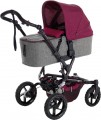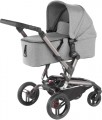Backrest tilt adjustment
The ability
to adjust the tilt between the seat and the backrest of the stroller. This helps to find the most comfortable position for the baby and adjust the seat to different situations: for example, at the end of a long walk, the backrest can be tilted back for a tired baby to take a nap.
Unit tilt adjustment
The ability to adjust
the tilt of the main unit relative to the stroller frame. This allows you to adjust the stroller to different situations: for example, at the beginning of the walk, the unit can be installed almost vertically, based on a sitting position, and later tilted back so that the baby can take a nap.
Front wheels diameter
The diameter of the front wheels installed in the stroller.
At the same time, the front wheels are not as important for mobility as the rear wheels: for example, to overcome obstacles, the stroller is often lifted "on its toes" by tilting it towards itself, with only the rear wheels working. Therefore, the diameter of the front wheels may be noticeably smaller than the rear wheels. It should be noted here that the small size also has its advantages — the wheels are lighter.
Speaking of specific numbers, diameter
up to 15 cm is considered very modest,
16 — 20 cm — small,
21 — 25 cm — medium,
26 — 30 cm is larger than average and
more than 30 cm is large.
Rear wheels diameter
The diameter of the rear wheels installed in the stroller.
The larger the wheel — the better it overcomes obstacles and bumps, the more convenient it is to drive the stroller over mud, snow and other difficult surfaces. For the rear wheels these moments are most relevant: for example, when driving the stroller over obstacles, it is usually tilted towards itself, so that the front wheels are in the air, and the rear wheels have to overcome the obstacle. On the other hand, small wheels weigh less and are easier to move, they are better suited for flat surfaces. So choose a stroller on this indicator should take into account the roads on which it has to be driven. If you plan to move on flat floors, good asphalt and stroller ramps — it is worth choosing small wheels, up to 20 cm. For difficult terrain, driving on mud and snow, regular overcoming steps and curbs it makes sense to pay attention to wheels in 30 cm and larger. And the diameter of 20 — 30 cm is an average option — it is suitable if you have to ride mainly on flat surfaces, but occasionally there is a need to overcome obstacles.
Seat width
The width of the seat installed in the stroller.
When selecting a seat, focus on the seat width, considering the child's build and allowing space for future growth, rather than the overall dimensions.
Weight (complete)
The total weight of the assembled pushchair. For universal models (see "Design"), this paragraph usually indicates the weight with the seat unit installed: such an accessory is used for a longer time than the carrycot, therefore its characteristics are considered the most important. In addition, the difference in weight between cradles and walking blocks usually does not exceed 700 – 800 g (there are exceptions, but quite rarely).
Comparing similar models, a lighter pushchair may offer more convenience, but it often comes at the expense of reliability or a higher price compared to a relatively heavier counterpart. It's important to note that weight varies based on the pushchair type (refer to "Design"). Heavier pushchairs provide stability, reducing the risk of tipping over. The lightest models, weighing
less than 5 kg, refer to pushchairs and single-seat ones. Models in the
6 – 10 kg are also mostly pushchairs, including variations for twins. The
11 – 15 kg range is standard for universal pushchairs and transformers. Models weighing
16 – 20 kg are notably heavy, while those
exceeding 20 kg are rare and found among high-end double-seat pushchairs.

